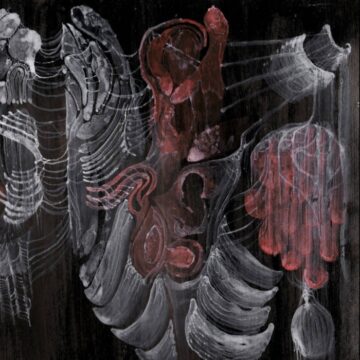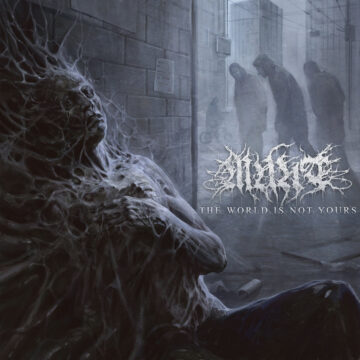Review: The Chronicles of Father Robin – The Songs & Tales of Airoea – Book III

Style: progressive rock, art rock, folk (clean vocals)
Recommended for fans of: Genesis, Yes, Jethro Tull, King Gizzard & The Lizard Wizard
Country: Norway
Release date: 23 February, 2024
Many things come in groups of three: beats of a joke, acts of a story, and of course things in this list. The Songs & Tales of Airoea is no exception, with Book III finally rounding out the triple concept album whose saga began last September and continued in December. This marks the end of The Chronicles of Father Robin’s lengthy debut opus, and finally I can look back over the trilogy with the full benefit of perspective. Where did the series succeed? What could have been improved? Although I have found elements to enjoy in my time with Father Robin, I find the former question far more present in my mind; TCOFR features clearly talented musicians, but no matter how many times they succeed at displaying that talent, they continue to struggle with the challenges of composition and putting on their best face for longer than a song or two at a time.
For better or for worse, Book III begins with by far its strongest track, and maybe the best of the series entirely. “Magical Chronicle” represents exactly what I want from this kind of art rock outing—it’s light and energetic, not afraid to be clever and complex with its eclectic turns in style and instrumentation, but also musically rich and entertaining. Come for the entrancing flute opening, stay for the (possibly synthesized) somber pipe organ towards the end. The track’s creative foundation carves out space for the band’s multi-part vocals to come out in full form with deep harmonies and full-throated tones, a demonstration of the band’s full capability to paint a vivid and enticing musical scene. Truly, I would have given so many things to have even a single album that sounded entirely like this; it keeps true to TCOFR’s signature style and creative vision, it’s fun and fulfilling to listen to, and with the added context from this momentary culmination of the artists’ talents, the project as a whole feels so much more successful and worthwhile.
Although the rest of the album can unfortunately only go downhill from there, it’s not a total washout. Continuing with “Skyslumber,” a spacier track, the style becomes much more reminiscent of Book II than the album opener was. With that comparison, though, I would also say that “Skyslumber” takes on that whimsical, meandering style in a more enjoyable way than any of the tracks on the prior album did. Between this, the lovely choral feature on the following track “Cloudship,” and the Yes-esque instrumental breakdown throughout the second half of “Empress of the Sun,” Book III impresses with its clearer vision and with a far more intricate and successful delivery thereof. Not all of that intricacy satisfies equally—there are any number of things I would rather do during the almost-spoken-word interlude around the four-minute mark of “Cloudship”—but in the sense of overall cohesion, this album surpasses Book II by far.
And yet, all good (or passable) things must come to an end. “Lost in the Palace Gardens” winds up just as lost (pun absolutely intended) in its own meandering composition as the worst offenders of Book II did. I find myself most reminded of bluegrass music in the song’s opening minutes, and while I appreciate the cultural efforts of a Norwegian band to approximate such a quintessentially American style, their plucky mandolin melodies just don’t measure up to what I’d expect from this branch of folk music—or indeed what I now know they are capable of, thanks to the opening track. Whether that’s what they intended to mimic or not, it’s hard to shake the comparison. Although the similarities fade in the latter half, starting on such a shortfall leaves the full experience feeling shaky and unfocused, and the listener gets plenty of time to ponder their impressions during the remainder of the song’s eight-minute bulk.
So finally, we reach the end of this journey. It’s been a real mixed bag, with plenty to praise but also plenty to criticize. The Songs & Tales of Airoea, across its now-considerable full runtime, struggles to maintain consistency of both style and quality. In part, this (or at least the part pertaining to style) is clearly intended, as The Chronicles of Father Robin offer a whole variety of musical talents and have wisely made efforts to put as many of those on display as they can. On the flip side, without sufficient care and consistency in composing their songs and the progression of musicality across each album (and the trilogy as a whole), these eclectic styles also often come across as unfocused and sloppy. With such a pitfall looming over the whole production, it’s difficult to give high praise to the Airoea trilogy, but at least it stands out for its uniqueness and flashes of genuine creativity.
Recommended tracks: Magical Chronicle, Cloudship, Empress of the Sun
You may also like: The Gardening Club, Albion, Wobbler, Jordsjø, Tusmørke, Pattern-Seeking Animals
Final verdict: 6/10
Related links: Bandcamp | Spotify | Official Website | YouTube | Facebook | Instagram
Label: Karisma Records – Bandcamp | Website | Facebook
The Chronicles of Father Robin is:
– Andreas Wettergreen Strømman Prestmo (vocals, guitars, keyboards, synths, percussion)
– Jon André Nilsen (bass, backing vocals)
– Henrik Harmer (percussion, synths, backing vocals)
– Regin Meyer (flute, keyboards)
– Thomas Hagen Kaldhol (guitars, mandolin)
– Aleksandra Morozova (backing vocals)
– Kristoffer Momrak (flute, synths)
– Håkon Oftung (keyboards, synths)
– Martin Nordrum Kneppen (percussion)
With guest:
– Lars Fredrik Frøislie (keyboards, synths)



0 Comments